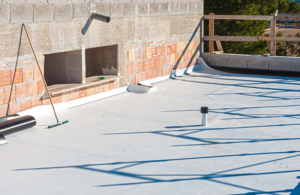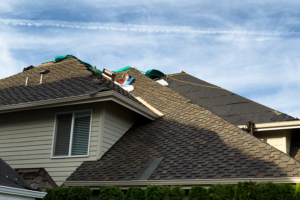Preparing your roof for storms and the environmental challenges that come with both standard and extreme storm events is about threat mitigation on your property. Do you have large trees with weak root systems, overhanging limbs, or damage to your roof? The combination of risks is unique to your property, but here are some common things to look for before the spring and summer storm season.
A professional inspection can reveal compromised elements in your roof such as cracked shingles, worn valley flashing, and damaged vents that may be difficult for you to spot on your own, and repair small problems on the spot. However, before you have the condition of your roof evaluated, there are some essential things to take care of first:
1. Check The Mountings Of Equipment On Your Roof.
While these things are not directly related to essential roof elements, they are sensitive to wind shear, and during a thunderstorm, there is a significant stress on the mounting hardware. If the bolts and brackets become loose, they will compromise the roof’s integrity and create a way for water to penetrate. Even a small amount of seepage can cause rot in the wooden sheathing and framing over time.
2. Look For Dead And Overhanging Tree Branches.
Yard irrigation can encourage some trees to develop shallow root systems. Be aware of what may happen if they fall. Some tree species are more apt to split at the trunk, particularly if they have been hit by lightning previously or if they get struck in the thunderstorm. If you see a potential problem with branches causing fall damage to your roof, then cut them down.
3. Clean Gutters And Downspouts.
It is crucial to thoroughly and quickly route water away from your home’s roof and foundation. If there are low spots in the gutter runs, there may be standing water, and if so, leaves, algae, and slime mold can build up. Once there is enough substrate in the gutter, you may have plants growing even in relatively dry climates. All this material will prevent water transport away from the roof and foundation and also become heavy enough to pull the gutter out from the attachment points and break the seals, creating another place for rot to get established. In addition to organic material, if you have asphalt shingles, which over 80% of homes do, normal wear granules will build up and limit capacity and add weight.
4. Check The Crawl Space Or Attic.
Look for any evidence of leaks, mold, staining, or softwood on the undersides of the sheathing and rafters, and if the vents appear to be clear of debris. However, if you do these checks yourself, be very careful, notify someone where you are, and wear appropriate safety equipment. Insulation is an irritant to the skin, nasal passages, and lungs. Put weight only on the ceiling joists since the ceiling drywall is not designed to hold more than about 15 pounds unsupported, and be very careful of exposed nails and equipment.
5. Check Skylights And Sun Tunnels.
Look closely for evidence of leaks and cracked or missing seals and caulking. Anywhere water can penetrate. Skylights can require inspection on the inside of the home as well as the roof.
6. Simple DIY Roof Repairs.
The primary threat of storms is wind. Preparing your roof for storms and keeping the wind from gaining purchase during a storm will save your roof. Some simple proactive repairs can prevent bigger problems and even roof failure later if problem areas are found. These include:
• Adding nails or tapping down those that may be popping up to strengthen the roof, better secure metal elements, and protect roof decking.
• Prevent roof deck and underlayment exposure by cementing any loose pieces. Once they lift with the wind, it doesn’t take much more to tear them.
7. Roof Types And Signs Of Repair Need.
Depending on your roof type, the indications that roof repair is needed are as follows:
A. Shingle roofing is by far the most common residential type. Shingles that receive damage from curling or excessive granule loss have lost sealing or are torn and need to be resealed or replaced. Valley, edge, and vent flashings have to be in alignment and properly sealed and not excessively corroded. If caulking is badly cracked or missing, it needs replacing.
B. Metal roofing is typically lower maintenance with higher initial material and installation costs. But, if wind lifts the metal sheets, there is a lot of surface area for it to work against. Fasteners and flashings must be tight and sealed, especially along leading edges.
C. Flat roofing on aging buildings can develop low spots, typically where the joists are unsupported, and water can pond. Water weighs about 8.3 pounds per gallon, and a ponded area on a flat roof can get heavy and put stress on the structure and cause it to sag further. The water barrier, sealant, flashings, fasteners, and caulking must all be in good condition. Any cracks, breaks, or flaws in the seams must be resealed immediately.
D. Tile Roofing can be attractive and long-lasting but does need occasional maintenance. Seals on fasteners, tiles, flashings, vents, and risers should be checked and resealed if needed. Chipped, delaminated, or loose tiles need to be repaired or replaced.
8. Get A Professional Inspection.
At this point, you are ready for a professional inspection of the roof itself for issues that are hard to spot and may require specialized equipment. Things a professional inspector will look for include curling, broken, and split shingles. They will check if nails are sticking up, loose attachment points on equipment, and broken seals around vents, skylights, and valley flashings. In addition to checking the condition of flashings and vents, which corrode and develop cracks that may be hard to see, a professional inspector will notice trouble spots such as excessive slope in the ridge-line.
RESOURCES
Blue Nail Roofing has a Master Elite contractor status awarded by the largest roofing manufacturer in North America, GAF. Only 2% of contractors in the US meet the rigorous standards to achieve this status, which means you can be assured you are making a smart choice when selecting the professionals at Blue Nail to execute your home and business roofing repairs. Contact us today to schedule a professional evaluation!
Copyright © 2020 Blue Nail Enterprises. All rights reserved. | Privacy Policy
Let Us Nail Your Project! We offer free estimates. Send us a little information about your roofing or home improvement needs, and an expert will reach out and get started.







